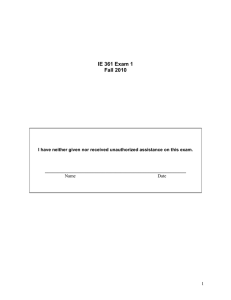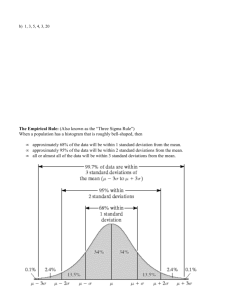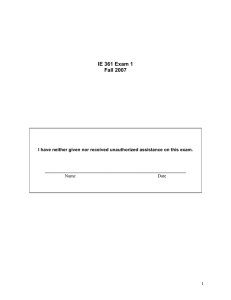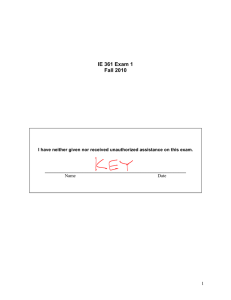IE 361 Exam 1 Fall 2006 ________________________________________________________
advertisement
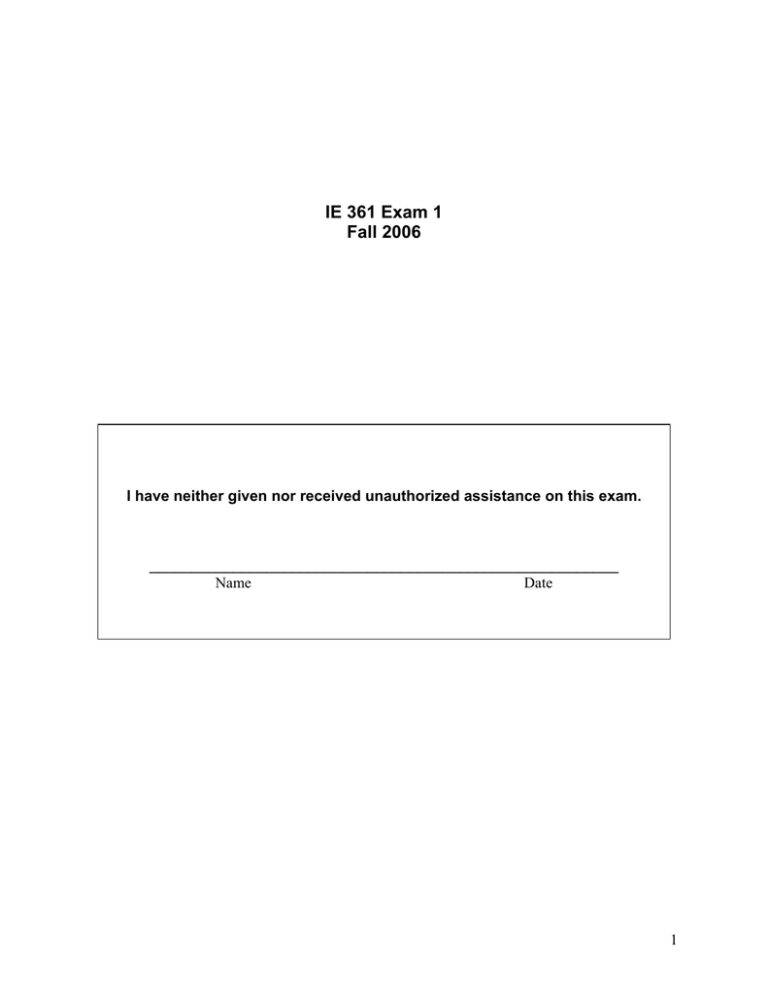
IE 361 Exam 1 Fall 2006 I have neither given nor received unauthorized assistance on this exam. ________________________________________________________ Name Date 1 This exam consists of 20 multiple choice questions. There is a single best answer for each question. Circle EXACTLY ONE response for each question on this answer sheet. 1. A B C D E 2. A B C D E 3. A B C D E 4. A B C D E 5. A B C D E 6. A B C D E 7. A B C D E 8. A B C D E 9. A B C D E 10. A B C D E 11. A B C D E 12. A B C D E 13. A B C D E 14. A B C D E 15. A B C D E 16. A B C D E 17. A B C D E 18. A B C D E 19. A B C D E 20. A B C D E 2 1. Rationale behind the "process orientation" of modern quality assurance a) presumes that good processes produce good outcomes. b) presumes that reworking items on a production line is an efficient way to achieve high quality. c) focuses on the use of robots as replacements for error-prone human beings. d) Exactly 2 of responses a) through c) are correct completions of the sentence. e) None of responses a) through c) are correct completions of the sentence. 2. a) b) c) d) e) "Quality" and "statistics" are related because guaranteeing quality requires gathering data and taking actions based on data. both quality and statistics are exclusively quantitative subjects. both quality and statistics are concerned in some way with "variation." Exactly 2 of responses a) through c) are correct completions of the sentence. All of responses a) through c) are correct completions of the sentence. 3. Regarding simple statistical graphics and quality assurance applications, a) histograms are basically "static" tools, giving a snapshot of process performance, but no sense of how process output has evolved. b) run charts portray process behavior over time. c) marking specifications on a graphic like a histogram or run chart allows one to get a quick sense of "process capability." d) None of responses a) through c) are correct completions of the sentence. e) All of responses a) through c) are correct completions of the sentence. 4. a) b) c) d) e) If a measurement device is perfectly calibrated it returns measurements of a measurand that are free of error. it has no bias of measurement. it has negligible imprecision. it fails to be "linear." None of responses a) through d) are correct completions of the sentence. 5. a) b) c) d) A standard (an item with corresponding "known" measurand x ) is needed in both measurement device calibration and determination of σ device . is needed in measurement device calibration, but not in determination of σ device . is not needed in measurement device calibration, but is needed in determination of σ device . is not needed for either device calibration or for determination of σ device . 6. A measurement device may have a bias as large as 1 unit (in absolute value) and a device standard deviation as large as 1 unit. You measure x and observe y = 10 . If you believe in the simple (normal) measurement model and want to report an interval you are "at least 99% sure" contains x , you should report limits a) 10 ± 1 . b) 10 ± 2 . c) 10 ± 3 . d) 10 ± 4 . e) None of the limits a) through d) is adequate. (Hint for 6: Before measurement, how far do you expect y to be from x with the indicated worst possible values of absolute bias and standard deviation?) 3 Fact: The upper 2.5% point of the F24,24 distribution is about 2.27. 7. The same axel diameter is measured n1 = 25 times on device #1 and n2 = 25 times on device #2, with resulting means and standard deviations y1 = 2.001 in , y2 = 2.004 in , s1 = .003 in , and s2 = .004 in . Based on 95% confidence limits, one can conclude a) that there is no clear difference in either device biases or standard deviations. b) that there is no clear difference in device biases, but there is a clear difference in device standard deviations. c) that there is a clear difference in device biases, but no clear difference in device standard deviations. d) that there are clear differences in both device biases and in device standard deviations. e) nothing about comparison of device biases or standard deviations since the true axel diameter is not known. 8. Two different (physically stable) production lines produce plastic pop bottles. n1 = 25 bottles from line #1 and n2 = 25 bottles from line #2 are burst tested on a single tester, with resulting means and standard deviations y1 = 201 psi , y2 = 202 psi , s1 = 3 psi , and s2 = 4 psi . Based on 95% confidence limits, one can conclude a) that there is no clear difference between mean burst strengths or consistencies of burst strengths produced on the two lines. b) that there is no clear difference between mean burst strengths, but there is a clear difference between consistencies of burst strengths on the two lines. c) that there is a clear difference between mean burst strengths, but no clear difference between consistencies of burst strengths produced on the two lines. d) that there is a clear difference between both mean burst strengths and between consistencies of burst strengths produced on the two lines. e) nothing about comparison of line mean burst strengths or consistencies of burst strengths since measurement is destructive and bottles can not be retested. (For questions 9 and 10) Using a single tester, a single metal specimen is tested for Brinell hardness 20 times, with resulting sample standard deviation of hardness 10 HB. Subsequently, 40 different specimens cut from the same ingot of steel have sample standard deviation of measured hardness 20 HB on this tester. 9. a) b) c) d) e) 95% confidence limits for a standard deviation measuring "test variability" for this tester are 16 HB to 26 HB. are 13 HB to 33 HB. are 8 HB to 15 HB. are 6 HB to 21 HB. can not be determined from the given information. 10. Approximate 95% confidence limits for a specimen-to-specimen standard deviation of actual Brinell hardness a) can not be determined from the given information. b) are 8 HB to 15 HB. c) are 16 HB to 26 HB. d) are 13 HB to 25 HB. e) None of responses a) through d) are a correct completion of the sentence. 4 11. Below is part of a JMP report from the analysis of a very small Gauge R&R study involving only I = 1 part and J = 2 operators. (The data are actually the "8D4 Ring Gear Height" data from problem 2.7 of SQAME.) Units used entering the data were 10−5 inch above 1.88000 inch . In these units, 95% confidence limits for the reproducibility standard deviation a) are not available based on the given information. b) are 0 in to 6595 ×10−5 in . c) are 557 ×10−5 in to 3642 × 10−5 in . d) are 0 in to 81×10−5 in . e) are 24 × 10−5 in to 60 × 10−5 in . Below is part of a JMP report from the analysis of an only slightly larger Gauge R&R study involving only I = 2 parts and J = 2 operators. (The data are actually the "8D4 and 31D4 Ring Gear Height" data from problem 2.7 of SQAME.) Units used entering the data were again 10−5 inch above 1.88000 inch . Use this JMP report in answering questions 12 and 13. 12. Based on this second report, 95% confidence limits for the repeatability standard deviation a) are impossible to determine. b) are 27 × 10−5 in to 51× 10−5 in . c) are 995 ×10−5 in to 1800 ×10−5 in . d) are 65 ×10−5 in to 4583 × 10−5 in . e) are 160 × 10−5 in to 1053 × 10−5 in . 13. Based on this second report, a single number estimate of σ reproducibility a) b) c) d) e) is 1247 × 10−5 in . is 35 ×10−5 in . is 1534 × 10−5 in . is 39 ×10−5 in . can not be determined. 5 14. An ANOVA analysis of a Gauge R&R data set produces σˆ R&R = 53 (in appropriate units) and νˆR&R = 3 . In these units, engineering specifications on a critical dimension of a machined steel part are nominal ± 200 . Approximate 95% confidence limits for a GCR (gauge capability ratio) for checking conformance to these specification are a) impossible to determine. b) .1 to .9 . c) .5 to 3.0 . d) .8 to 1.6 . e) 1.0 to 6.0 . 15. 95% confidence limits for a particular gauge capability ratio are .6 to .8 . This indicates a) that the gauge is inadequate for checking conformance to the specifications in question. b) that the gauge is adequate for checking conformance to the specifications in question. c) more data are needed to determine whether the gauge is adequate for checking conformance to the specifications in question. d) there are clearly problems with the accuracy of the gauge. e) Exactly 2 of the responses a) through d) are correct completions of the sentence. Below is part of a JMP report from the analysis of a calibration data set. Use it in answering questions 16 and 17. The data are from an analyzer that returns light intensities y (in unspecified units) for specimens of Riboflavin concentration x (in mcg/mL). 16. 95% confidence limits for a repeatability standard deviation for this analyzer are a) .6 to 1.8 intensity units . b) 1.2 to 3.5 intensity units . c) 1.5 to 4.4 intensity units . d) 2.3 to 6.5 intensity units . e) impossible to determine from the given information. 6 17. Tomorrow this analyzer is used on an unknown specimen and y = 75 intensity units is read on the display of the analyzer. 95% confidence limits for the Riboflavin concentration of the sample a) can not be determined from the information provided. b) are .50 to .57 mcg/mL . c) are .52 to .55 mcg/mL . d) are 4.3 to 8.6 mcg/mL . e) are 123.9 to 134.4 mcg/mL . The final step in the production of some glass vials is a visual inspection presently carried out by human inspectors. A particular single vial (marked in an "invisible" ink that can be seen only under ultraviolet light) known to be defective is repeatedly run through the inspection process among a large number of newly produced vials. In fact, each of 5 company inspectors sees that vial 10 times in a company study. Below are the rates at which that vial was identified as defective by the operators .6,.9,.9,1.0,1.0 18. Inconsistency of the "defective/non-defective" calls made by a particular single inspector a) is a kind of "repeatability" variation. b) is modeled using a binomial distribution. c) is reflected in values of p̂ that are neither 0 nor 1. d) Exactly 2 of responses a) through c) are correct completions of the sentence. e) All of responses a) through c) are correct completions of the sentence. 19. On the scale of (estimated) variances (not standard deviations) the fraction of overall variation seen in the "defective/non-defective" calls that should be attributed to operator-tooperator differences is closest to a) 0 b) .1 c) .2 d) .3 e) .4 20. A comparison between one of the operators that made all "defective" calls and the one that made 6 out of 10 such calls can be made using approximate 95% confidence limits (for the difference in long run fractions of "defective" calls) a) .4 ± 1.96 (.04 ) b) .4 ± 1.96 (.15 ) c) .4 ± 1.96 (.19 ) d) .29 ± 1.96 (.04 ) e) .29 ± 1.96 (.19 ) 7
